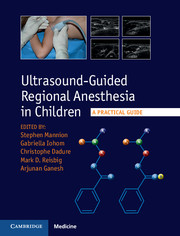Book contents
- Frontmatter
- Contents
- List of contributors
- 1 Introduction
- Section 1 Principles and practice
- Section 2 Upper limb
- Section 3 Lower limb
- 11 Ultrasound-guided femoral nerve block
- 12 Ultrasound-guided saphenous nerve block
- 13 Ultrasound-guided sciatic nerve block
- Section 4 Truncal blocks
- Section 5 Neuraxial blocks
- Section 6 Facial blocks
- Appendix: Muscle innervation, origin, insertion, and action
- Index
- References
12 - Ultrasound-guided saphenous nerve block
from Section 3 - Lower limb
Published online by Cambridge University Press: 05 September 2015
- Frontmatter
- Contents
- List of contributors
- 1 Introduction
- Section 1 Principles and practice
- Section 2 Upper limb
- Section 3 Lower limb
- 11 Ultrasound-guided femoral nerve block
- 12 Ultrasound-guided saphenous nerve block
- 13 Ultrasound-guided sciatic nerve block
- Section 4 Truncal blocks
- Section 5 Neuraxial blocks
- Section 6 Facial blocks
- Appendix: Muscle innervation, origin, insertion, and action
- Index
- References
Summary
Clinical use
Saphenous nerve blockade is useful for analgesia after knee surgery as part of a multimodal approach (Flack and Anderson, 2012). The saphenous nerve is mainly a sensory nerve (Hebl and Lennon, 2010). The saphenous nerve block, unlike the femoral nerve block, has significantly less motor blockade of the quadriceps as only the vastus medialis is affected, thus allowing early mobilization and rehabilitation (Kim et al., 2014).
It is useful for operations on the anteromedial and posteromedial aspect of the leg from the knee to the ankle (Kent et al., 2013). It may be performed in combination with a popliteal block for ankle surgery.
The saphenous nerve block is increasingly replacing the femoral nerve block for analgesia after knee surgery including total arthroplasty (Kim et al., 2014).
The use of ultrasound guidance for saphenous nerve block is relatively new (Krombach and Gray, 2007) with limited experience in pediatric practice.
The commonest clinical use in children is for knee arthroscopic diagnostic and treatment surgeries.
The anatomy of the saphenous nerve is such that it is accessible for ultrasound-guided blocks at multiple points in the thigh (Hunter et al., 1979; Kent et al., 2013).
Clinical sonoanatomy
The saphenous nerve is the largest cutaneous branch of the femoral nerve and is considered its terminal branch from the posterior division of the femoral nerve. It travels with the femoral artery down the medial aspect of the leg giving off an infrapatellar branch that provides innervation to the skin covering the knee. The saphenous nerve then exits between the sartorius muscle and gracilis tendon and continues down to supply the anteromedial aspect of the leg usually until the medial malleolus (although its sensory innervation may extend beyond the malleolus to the medial aspect of the foot).
The ultrasound image will depend on where along the inner thigh the probe is placed and, therefore, the relationship of the nerve with the femoral artery (Figure 12.1). In the proximal third of the thigh the saphenous nerve separates from the femoral artery after crossing it from lateral to medial. It then courses through the adductor canal (also called subsartorial canal or Hunter canal) with the femoral artery, and emerges from the canal with the saphenous branch of the descending genicular artery.
- Type
- Chapter
- Information
- Ultrasound-Guided Regional Anesthesia in ChildrenA Practical Guide, pp. 90 - 94Publisher: Cambridge University PressPrint publication year: 2015

